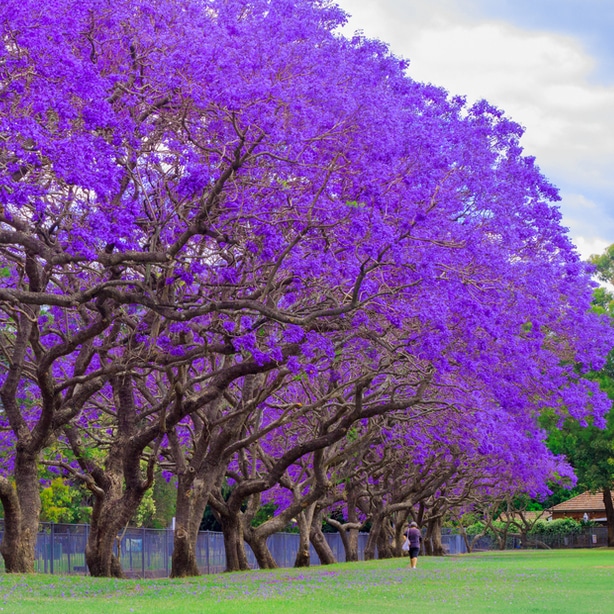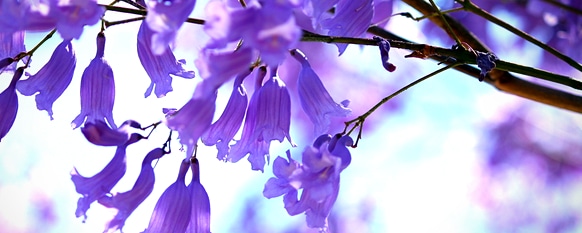If you are considering adding some color to your landscape, look no further than the jacaranda tree. Filling the spring sky with a cloud of purple, it is a stunning sight to behold. It’s easy to see why this beauty is popular with gardeners in all tropical and subtropical areas.
Take some time to learn some of the proper trimming techniques for arborvitae. Check out our guide to prevent making mistakes.
The southern native is also called a fern tree. A close look at its long, feathery leaves explains why. Each spring, the soft-looking leaves are pushed aside by attractive, trumpet-shaped, long-lasting purple or pink flowers.
Once you see a purple hue emerging, you know that spring has arrived. And who doesn’t want to welcome a new growing season with all the fanfare it deserves?
If you’re considering adding a jacaranda to your landscape, read on for all the important details. Included below is everything from basic characteristics to how to promote healthy growth.

General Information
Jacarandas are subtropical and native to central and southern South America. Commonly called jacaranda or blue jacaranda.
Although the genus contains numerous different species, Jacaranda mimosifolia is the most common. It’s a popular and hardy tree cultivated in subtropical and tropical climates. Therefore, it’s hardy growing in USDA zones 9 through 11.
In fact, it’s so hardy that southeastern Queensland, Australia considers the shrub an invasive species.
The woody plants are fast-growing, and their branches are often prone to breaking. Mature trees grow up to be about 40 feet tall and 60 feet wide.
The species grows naturally into an open, vase-like shape with a spreading canopy. There can be a single or multiple trunks. Graceful branches are filled with green, feather-like foliage. During fall and winter, the deciduous leaves become yellow before dropping. In its warmest locations, the tree can be semi-evergreen.
Despite the jacaranda’s graceful beauty, what sets it apart is its extravagant blooms. Spring through summer, the tree forms 18-inch-long panicles. They fill with clusters of lightly scented, violet-purple or lavender, trumpet-shaped flowers. The cultivar “Alba” produces white flowers.
The flowers can fill the canopy with intense color before the foliage emerges in the spring.
The spent flowers form into round fruits that turn hard and brown when ripe. The fruit contains the plant’s seeds.

Care Guide
When grown in their preferred climate and conditions, this species is a breeze to take care of. It doesn’t take much to keep them healthy and happy in your yard.
Amount of Sun
The species prefers a location in full sun. It performs best when it receives eight to 12 hours of direct sunlight daily. However, saplings tolerate light shade.
Keep in mind that although a jacaranda tolerates growing in partial shade, it will grow better and flower more profusely in a sunny location. Too much shade means fewer flowers.
Young saplings can be grown in a pot. If you need to bring the potted plant inside because of a cold-weather spell, place the pot in a sunny location, near a south- or west-facing window. Due to its fast growth and ultimate size, a sapling will eventually need to be transferred into the ground.
Soil Conditions
This species prefers soil that drains well. Soggy soil can lead to root rot, which will kill the plant. It will grow best and produce the most flowers when planted in sandy soil or loamy soil with good drainage.
If you are growing a sapling in a pot, use a light potting mix and make sure the pot drains well.

If you like flowering trees, you might also want to check out our weeping cherry tree guide.
Watering Frequency
Several factors influence the frequency and amount of water it requires. Climate, soil type, and season all play an important role. It’s always best to water deeply. Saturate the soil to a depth of around 2 feet.
If the species is planted in sandy soil, you can expect to water twice weekly, especially if conditions are hot and dry. If the soil is loamy, expect to water only once each week.
If your location is experiencing an especially hot and dry summer, you may have to water more frequently.
During winter, the jacaranda stops actively growing. This means you can cut back watering to monthly applications.
Water potted jacarandas when the top several inches of soil become dry. Stick your finger into the soil, and if it feels dry, apply water.
You can help the soil conserve its moisture by using mulch. Spread several inches of organic mulch under the tree’s canopy. Just be sure to keep it pulled back several inches from the trunk to prevent pest and disease problems
Fertilization
Fertilize this species with a general-purpose blend for trees. May is usually a good time. This plant does not need much extra nutrition, so one application per year is sufficient. Select a 10-10-10 fertilizer and apply it according to the package instructions.
Don’t stress if you forget to fertilize. The plant is forgiving and often thrives even in poor conditions. One missed feeding won’t kill it.
Spread the fertilizer evenly under the tree’s canopy. Lightly scratch it into the soil, and then apply water. Be sure not to butt the product against the trunk to prevent burning.
If you have a young jacaranda growing in a pot, use a general-purpose, water-soluble fertilizer blend. Mix and apply before watering. Apply in spring.

Pruning
Do any major pruning in fall and winter, when the plant is not actively growing. However, you can remove broken, crossing, or diseased branches year-round. Unpruned trees with more than one trunk develop a weak structure and are prone to splitting.
Pruning while the woody plant is still young is important Now is the time to remove all but the healthiest-looking central trunk. This will create a strong structure. Trim all additional volunteer trunks to ground level as they sprout.
Prune to keep major branches spaced apart and open. Never trim off more than one-fifth of the canopy, as that can weaken the tree.
For your plant to develop a strong structure and shape, prune at least every three years. Otherwise, splitting and breaking branches can be a hazard.
Be sure to use clean pruning tool blades when making your cuts. You don’t want to transfer a disease or pest to the tree accidentally.
Design Ideas
Jacarandas make gorgeous additions to any landscape, especially when they burst into bloom with either purplish or white flowers. They can brighten any yard with non-stop color and add a tropical flair. In portions of California, they are used as showy street trees, filling neighborhoods with a haze of purple.
Jacarandas make great shade trees, offering dappled shade in an area with full sun. You can relax under the feathery foliage and beat the heat of a summer day.
Because of its large size when fully mature, this plant works best in medium-sized to large yards. Their spreading canopy can overpower a small landscape.
Their graceful and flowing branches make it an attractive addition planted by a patio or porch. It also is quite showy when situated in a place where it can be an elegant canopy over a walkway.

Design Considerations
When selecting a location for this species, you need to consider several factors.
Don’t plant it too closely to a structure or powerline. Because the wood is prone to breaking, falling branches might cause damage if they hit part of a building or pole.
Between falling flower petals, leaves, and fruit, the tree can be quite messy. So don’t plant it near a swimming pool. Otherwise, you’ll have to continually worry about the pool filter clogging up. And rather than taking a dip in the cool water, you’ll be cleaning up the area around the pool.
Jacarandas have a vigorously growing root system. Therefore, you don’t want to plant the tree too close to water or sewer lines or a sidewalk. The roots can cause damage to the lines and lift the sidewalk.
Companion Plants
You can choose from a variety of plants that grow well as companions. Whether you’re looking for low-growing ground covers, shrubs, or another tree, there’s plenty to select from.
Consider a plant that thrives in the same conditions as the jacaranda and perhaps one that adds color when the tree is no longer in bloom.
Companion Trees
A few trees that compliment jacarandas are:
- Royal Poinciana (Delonix regia) – Red flowers in early to late summer.
- Yellow Poinciana (Peltophorum pterocarpum) – Yellow flowers in summer to fall.
- Orchid Tree (Bauhinia spp.) – Red, white, purple, yellow, and pink flowers year-round.
Companion Shrubs
Shrubs that work well growing with jacarandas include:
- Croton (Croton spp.) – Colorful evergreen foliage year-round.
- Plumbago (Plumbago spp.) – Year-round blue flowers.
- Indian Hawthorn (Raphiolepis indica) – Evergreen producing white spring flowers.
Ground Covers
Some ground covers that compliment jacarandas include:
- Liriope (Liriope spp.) – Evergreen with green or variegated grass-like foliage.
- Bromeliads (Bromeliad spp.) – Evergreen producing flowers in various forms and colors.
- Boston Fern (Nephrolepis exaltata) – Evergreen with airy, feathery foliage.
Wherever you decide to plant your jacaranda and regardless of companions, it’s sure to be a showstopper.

